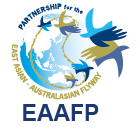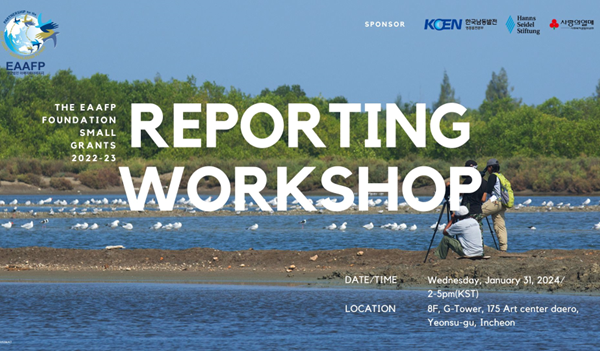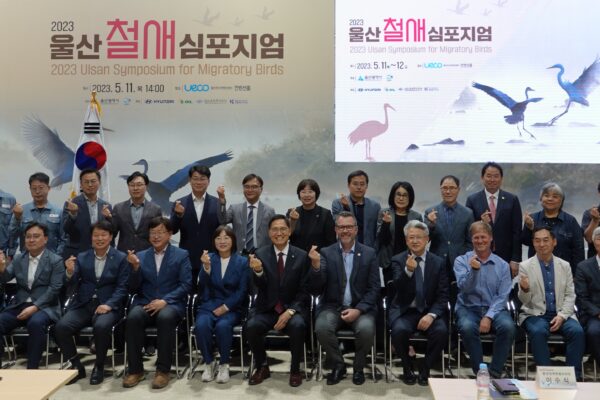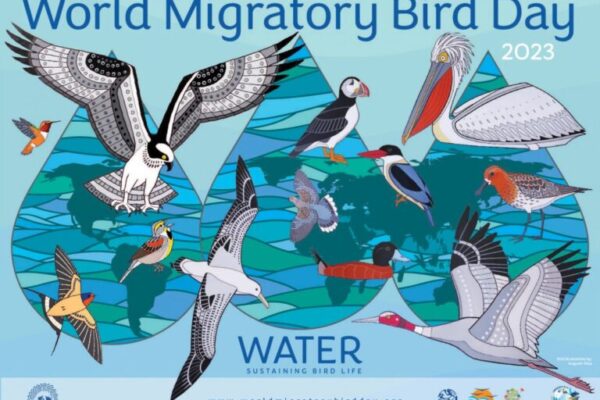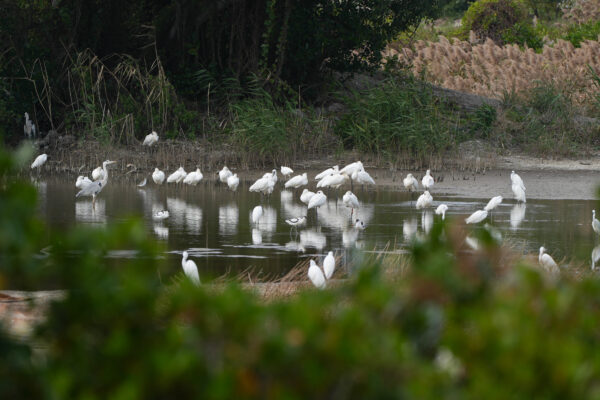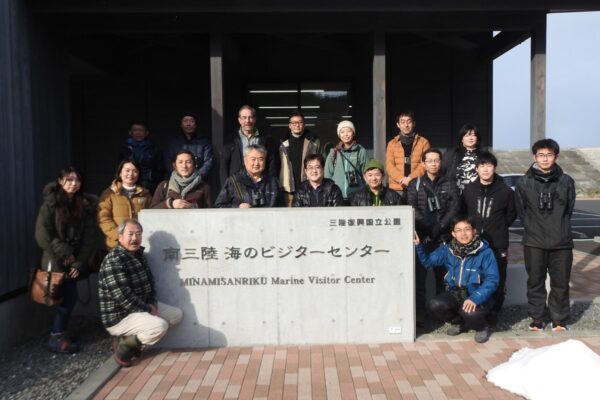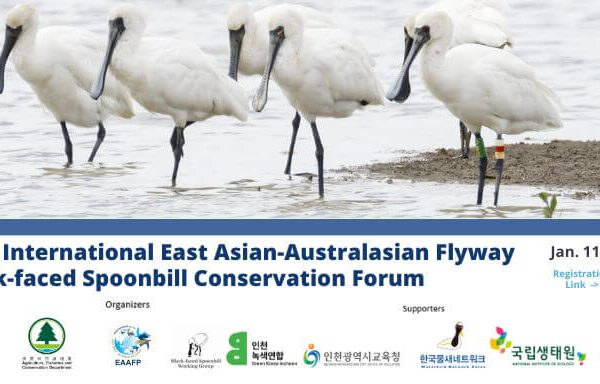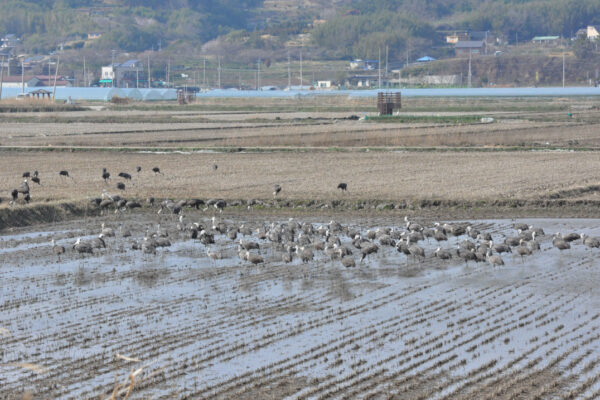-
EAAFP Foundation 2022-2023 Small Grant Fund Reporting Workshop
Discussing a Potential Global Impact of Domestic Migratory Waterbird Conservation Efforts ©EAAFP On January 31st, the Reporting Workshop of the EAAFP Foundation’s…
Continue reading -
2023 Incheon International Education Forum : Policies and Practices on Climate Change Education in North-East Asia
©UNESCAP As Climate Change is an emerging global issue in the past decade, its impacts cannot be addressed without the participation of all generations. In particular, young people will be mostly taking the risk and consequences of Climate Change for the longest duration. Therefore, it is crucial to provide high-quality climate change education by strengthening the capacity of educators and empowering youth in the efforts to tackle climate change. In light of this, the Incheon Metropolitan City Office of Education and the UN ESCAP Subregional Office for East and North-East Asia jointly organized the "2023 Incheon International Education Forum" on May 30-31, 2023, in Incheon, Republic of Korea. The forum centered around the theme of "Policies and Practices on Climate Change Education in North-East Asia." The forum aimed to promote the exchange of knowledge and experiences, focusing on climate change education (CCE) in the East and Northeast Asia region. It aimed to discuss how stakeholders can collaborate to provide effective climate education to the youth. Over 50 participants from the education sector, including school teachers and students, as well as international and local organizations, joined the forum, which consisted of six sessions. The forum began with an opening ceremony featuring remarks by Ms. Miyoung Lee, President of the Incheon East Asia Global Education Institute, Mr. Ganbold Baasanjav, Head of the East and North-East Asia Office, UNESCAP, and Mr. Chungsik Sin, Chairperson of the Education Committee, Incheon Metropolitan Council. Two keynote speeches were delivered by Mr. Seonghoon Do, Superintendent of the Incheon Metropolitan City Office of Education, and Mr. Henry Gonzalez, Executive Director a.i. of the Green Climate Fund. The first session, titled "Policies on Climate Change Education," focused on researchers from China, Japan, Mongolia, and South Korea sharing the current status of Climate Change Education in their respective countries. In the second session, titled "Student-friendly Climate Curriculum and Programs," presenters from China, Mongolia, and South Korea emphasized the importance of developing curricula on climate change-related subjects. They discussed the situation of CCE programs in schools from the perspectives of NGOs and researchers, evaluating and sharing gaps in CCE. The last session of Day 1 was dedicated to "Capacity Building for Educators." Presenters from WWF-China, UNESCO (ACCU), and the Incheon Metropolitan City Office of Education shared their programs aimed at equipping and training educators on CCE. They also discussed strategies for building collaboration and networks for CCE or environmental education in the region. On Day 2, the fourth session, titled "Climate Education Activities at a City and/or Community Level," commenced with a series of five presentations highlighting educational activities for young people both inside and outside of school. The speakers represented diverse backgrounds, ranging from NGOs like the Climate Change Center and Youth Origin Education in China to local schools in Japan and South Korea. Ms. Vivian Fu, Senior Communication Officer of the EAAFP Secretariat, also shared insights on linking Climate Change Education (CCE) to wetlands and advocated for leveraging existing educational facilities at these sites to enhance CCE. Vivian Fu, Senior Communication Officer of the EAAFP Secretariat, presenting about the links of conservation of wetland and migratory waterbirds with Climate Change Education (CCE) ©UNESCAP Session 5 focused on Global Developments in Climate Change Education, featuring panelists such as Ms. Won Jung Byun from UNESCO Headquarters, Mr. George Zedginidze, Head of Knowledge Management at the Green Climate Fund, Mr. Mozaharul Alam, Regional Coordinator for Climate Action at UNEP Asia and the Pacific Office, and Ms. Elly Herliani from the Southeast Asian Ministers of Education Organization. They discussed ways and mechanisms through which their organizations could incorporate CCE activities and synergize strategies and resources. Following that, a special session titled "Voices of the Youth" was held, during which five students from middle and high schools in Incheon presented their activities, including studying birds and plants at wetlands and conducting awareness-raising activities at schools and local communities. All participants were deeply impressed by the work and enthusiasm demonstrated by these students. The students also actively participated in the final session, an interactive discussion on future (sub-)regional cooperation in climate change education, alongside all the participants. The presenter from NGO Youth Origin Education (left) and student presenters (right) ©UNESCAP For more information on the event and presentations, please visit: https://unescap.org/events/2023/2023-incheon-international-education-forum-policies-and-practices-climate-change
Continue reading -
EAAFP leads happy companionship of humans and nature through the Ulsan Symposium for Migratory Birds
©EAAFP Secretariat On 11th May, the 2023 Ulsan Symposium for Migratory Birds was held to celebrate World Migratory Bird Day at the Ulsan Convention and Exhibition Center (UECO) under the theme of “Migratory birds of Taehwa River and their habitat conservation plan.” The 2023 Ulsan Symposium for Migratory Birds was co-hosted by EAAFP and Ulsan Metropolitan City and sponsored by the four Ulsan companies, Kyungdong City Gas co., Ltd., Korea Petrochemical Ind. Co., LTD., S-Oil Corporation, and Hyundai Motor Company. As part of the Ulsan Corporate Champion Programme, the symposium was achieved through the cooperation for the conservation of migratory birds and their habitats, following the designation of the Ulsan Taehwa River (EAAF150) as an EAAFP Flyway Network Site (FNS) and the signing of an MoU among EAAFP, Ulsan Metropolitan City, and Ulsan corporates in 2021. The symposium consisted of birdwatching and habitat clean-up activities with the four Ulsan Corporate Champions in the morning and a symposium in the afternoon. About 60 employees of Kyungdong City Gas, Korea Petrochemical, S-Oil, and Hyundai Motor Company participated in the EAAFP Ulsan Corporate Champions’ Activity for Conservation of Migratory Birds during the morning of the 11th to observe migratory birds in the Taehwa River and clean up the migratory bird habitats, thereby practicing ESG management. Employees of the four Ulsan corporates toured the Taehwa River area with nature guides to observe migratory birds such as Great Cormorants and Eastern Great Egrets and did habitat cleaning around the area to create a clean environment for the birds living in the Taehwa River. EAAFP Ulsan Corporate Champions’ Activity for Protecting Migratory Birds ©EAAFP Secretariat Employees of four EAAFP Ulsan Corporate Champions engaged in birdwatching and environmental cleanup activities ©EAAFP Secretariat The Ulsan Symposium for Migratory Birds held in the afternoon was attended by various stakeholders, including the four Ulsan corporates that are actively serving as Species Champions in the EAAFP Corporate Champion Programme, the Ulsan Metropolitan City Special Advisor for Environmental Policy, the EAAFP Secretariat, experts, FNS-listed cities, civic groups, research institutes, and corporates, who gathered to seek ways to conserve migratory birds and their habitats. The keynote presentation was given by Mr. Tim McGrath, the Head of Project Development at WWT (Wildfowl & Wetland Trust). Prof. Jong-nam Lee, Kyungsung University, Dr. Won-ho Lee, Nakdong Estuary Eco-Center of Busan Metropolitan City, and Mr. Seong-jin Kim, Upo Ecological Ibis Division of Changnyeong County Tourism and Environment Department, presented during the first session on “Status of migratory birds and Habitat Management in Taehwa River.” The second session on “Happy Companionship Between Nature and Humans” was delivered by Mr. Myeong-ok Kim, SK Energy CLX External Team Leader, Dr. Donguk Han, Director of Eco Korea PGA Ecology Institute and Adjunct Professor at Catholic University, and Ms. Jisun Lee, EAAFP Foundation Coordinator. Prof. Gea-jae Joo of Pusan National University served as the moderator of the third session which had Q&A and discussion. Before the symposium began, Mr. Soo-sik Lee, the Special Advisor for Environmental Policy of Ulsan Metropolitan City gave a commemorative speech. Mentioning the restoration of the heavily polluted Taehwa River through the cooperation of Ulsan citizens, corporates, and various organizations, he said he hoped this symposium would serve as an opportunity to share experiences and knowledge and find a way for migratory birds and people to coexist more happily. Following this, EAAFP Deputy Ms. Yeounhee Ahn gave a congratulatory speech and thanked Ulsan Metropolitan City for their efforts to conserve migratory birds and their habitats in Ulsan, and the four Ulsan corporates who have been actively serving as Species champions in the Ulsan Corporate Champion Programme. She also emphasized that cooperative activities between Ulsan Metropolitan City and participating Ulsan corporates will become a good role model of corporate partnership for conservation and expand domestically and internationally. Mr. Soo-sik Lee, Special Advisor for Environmental Policy of Ulsan Metropolitan City, delivering a commemorative speech ©EAAFP Secretariat Ms. Yeounhee Ahn, EAAFP Deputy, delivering a congratulatory speech ©EAAFP Secretariat The symposium kicked off with a keynote presentation by Mr. Tim McGrath, the Head of Project Development at WWT. Mr. Tim McGrath emphasized that the climate, nature, and welfare crises facing the world can be addressed with nature-based solutions through the creation of blue infrastructure, i.e., wetlands. He highlighted the various benefits of wetlands, such as carbon storage, welfare improvement, flood reduction, and biodiversity restoration, and said that wetland creation and management are necessary. To achieve this, he said, we need to build the capacity of stakeholders to procure and strengthen the necessary public and private partnerships and collaborations. Mr. Tim McGrath, the Head of Project Development at WWT, delivering a keynote presentation ©EAAFP Secretariat After the keynote presentation by Mr. Tim McGrath, the first session, “Status of migratory birds and Habitat Management in Taehwa River” began. In the first presentation, Prof. Jong-nam Lee of Kyungsung University introduced the status of migratory birds in the Taehwa River and Taehwa River’s role as a habitat and stated that standardization and methodology of surveys should be developed to strengthen the bird survey necessary for the conservation of the Taehwa River. He called for long-term training and support at the municipal level to strengthen and nurture the capacity of citizen monitoring groups. Prof. Jong-nam Lee, Kyungsung University, giving a presentation ©EAAFP Secretariat Dr. Won-ho Lee of Busan Metropolitan City Nakdong Estuary Eco-Center informed the participants of the efforts needed to restore the destroyed ecosystem by introducing the process of transforming the Nakdong River Estuary (EAAF097) from a sewage treatment plant and landfill to migratory bird habitat and its current status. The importance of the active role of local government was emphasized in the ongoing ecosystem conservation and maintenance projects, such as the Little Tern habitat restoration project and the conservation measures for swans. Dr. Won-ho Lee, Busan Metropolitan City Nakdong Estuary Eco-Center, giving a presentation ©EAAFP Secretariat Mr. Seong-jin Kim of Upo Ecological Ibis Division at the Changnyeong County Tourism and Environment Department shared the restoration project of the Asian Crested Ibis (EN) habitat in Upo Wetland (EAAF096), which is preparing for successful release into the wild after artificial breeding of extinct Asian Crested Ibises in Ro Korea and emphasized that a community-wide effort is needed for a restoration project. In addition, the successful restoration of Asian Crested Ibises raised the need for considering the impact on the lives of the locals and cooperation with the local community. Mr. Seong-jin Kim, Upo Ecological Ibis Division of the Changnyeong County Tourism and Environment Department, giving a presentation ©EAAFP Secretariat The second session, “Happy Companionship Between Nature and Humans,” began with a presentation by Mr. Myeong-ok Kim, SK Energy CLX External Team Leader. Mr. Myeong-ok Kim emphasized that the happiness of the local community should be given priority through the case of SK Innovation's transition from CSR (Corporate Social Responsibility) to ESG (Environmental, Social, and Governance). He also suggested building a platform to engage all stakeholders to address community issues, emphasizing that the conservation of migratory birds and their habitats is a shared goal for all in the community. Mr. Myeong-ok Kim, SK Energy CLX External Team Leader, giving a presentation ©EAAFP Secretariat In the following presentation by Dr. Donguk Han, Director of Eco Korea PGA Ecology Institute and Adjunct Professor at Catholic University, Dr. Donguk Han cited the Han River Estuary Janghang Wetland (EAAF143), a Ramsar site, as an example of conservation activities involving corporates and civil society and discussed the synergistic effect of trilateral cooperation among non-governmental organizations, corporates, and local governments in the conservation of habitats and biodiversity. Dr. Donguk Han, Director of Eco Korea PGA Ecology Institute, giving a presentation ©EAAFP Secretariat As a final presentation, Ms. Jisun Lee, EAAFP Foundation Coordinator, introduced EAAFP's Corporate Champion Programme, a platform that can internationally certify corporate’s social and environmental contributions, and shared the example of the partnership with the Ulsan Corporate Champions for migratory birds and habitat conservation along with the future plans in the partnership. After the presentation, an appreciation plaque presentation ceremony was held for four Ulsan corporates that contributed to the conservation of migratory waterbirds and their habitats as Species Champions of the EAAFP Corporate Champion Programme. EAAFP Deputy Ms. Yeuon-hee Ahn presented plaques of appreciation to Kyungdong City Gas, Korea Petrochemical, S-Oil, and Hyundai Motor Company, who are actively serving as Species Champions of Black-crowned Night-Heron, Eastern Great Egret, Mandarin Duck, and Long-billed Plover, respectively. Ms. Jisun Lee, EAAFP Foundation Coordinator, giving a presentation ©EAAFP Secretariat Appreciation plaque presentation ceremony for four Ulsan corporates who are serving as Species Champions of the EAAFP Corporate Champion Programme ©EAAFP Secretariat The discussion and Q&A that followed were moderated by Prof. Gea-Jae Joo of Pusan National University. Based on the presentations, the panelists shared their opinions and the discussion proceeded with a Q&A session with the general participants. Prof. Gea-jae opened the discussion by emphasizing that conservation measures and activities of Ulsan Metropolitan City and Ulsan corporates should continue in a virtuous cycle structure through this symposium. In addition, he proposed the creation of a civil society organization specializing in birds in order to build a closer cooperative relationship between Ulsan Metropolitan City and civil society organizations. Ms. Hwa-ja Shin, Natural Environment Team Leader at the Environmental Policy Division of Ulsan Metropolitan City, said that based on the conservation plan discussed at the symposium, Ulsan Metropolitan City would conserve and protect the existing migratory bird habitat together with citizens and corporates. The symposium ended with a closing ceremony and the distribution of Ulsan Corporate Champion Programme goods which were sponsored by the Ulsan Corporate Champions. Panelists participating in the discussion ©EAAFP Secretariat In the 12th, the day after the symposium, Taehwa River birdwatching, Taehwa River National Garden tour, and EAAFP corporate champion S-Oil visit were provided for the symposium participants who wished to attend. The participants were able to reaffirm the history of the Taehwa River and its importance as a habitat in the city that connects migratory birds and Ulsan citizens by visiting the Taehwa River National Garden. Lastly, through a visit to S-Oil Onsan Plant, they were able to take a closer look at the partnership with the local community and ESG management of S-Oil, which is actively serving as the EAAFP Ulsan Corporate Champion. Ulsan Symposium for Migratory Birds participants birdwatching at Taehwa River and touring the Taehwa River National Garden ©EAAFP Secretariat Ulsan Symposium for Migratory Birds participants visiting S-Oil Onsan Plant ©S-Oil Learn more about the EAAFP Corporate Champion Programme Read an article about 2022 EAAFP Ulsan Corporate Champion Programme activity
Continue reading -
World Migratory Bird Day 2023 highlights impact of the growing water crisis on migratory birds
BOULDER/BONN/INCHEON, 13 May 2023 – Water and its importance to migratory birds – and the increasing threats to both water quality and quantity - is the focus of this year’s World Migratory Bird Day, a global campaign that aims to raise awareness of migratory birds and the need for international cooperation to conserve them. Activities to mark the campaign will be held globally on two peak days in May and October under the theme “Water: Sustaining Bird Life” Water is fundamental to sustaining life on our planet. Migratory birds rely on water and its associated habitats—lakes, rivers, streams, ponds, swamps, marshes, and coastal wetlands—for breeding, resting, refueling during migration, and wintering. Yet increasing human demand for water, along with climate change, pollution, and other factors, are threatening these precious aquatic ecosystems. Headlines around the world are sounding alarm: 35 percent of the world’s wetlands, critical to migratory birds, have been lost in the last 50 years. Utah’s Great Salt Lake, the largest saltwater lake in the Western Hemisphere and used by more than a million shorebirds, is in danger of disappearing within five years. Across the Amur-Heilong Basin in Asia, climate change is amplifying the impact of habitat destruction by depleting natural water systems and depriving migratory birds of vital breeding and stopover site. These sobering examples go hand-in-hand with recent reports that reveal that 48 percent of bird species worldwide are undergoing population declines. Another poignant example is that of the Aral Sea shared by Kazakhstan and Uzbekistan. Once the fourth-largest lake in the world, it is widely regarded as one of the planet’s worst water-related environmental disasters. Soviet-era irrigation projects almost completely dried up the lake, which led to the loss of livelihoods for fishermen and farmers and the deterioration of public health due to toxic dust and reduced access to clean water. The impact has been severe for the communities around the lake, but also for migratory birds, which lost important food sources and a critically important stopover point on their journey. Another example is the Sahel, a vast semi-arid region in Africa: Prolonged periods of drought, deforestation, and overgrazing in the Sahel have led to the degradation of the soil and loss of vegetation, threatening the survival of both the local human population and wildlife, including migratory birds. Lake Chad, one of the largest water bodies in Africa in 1960, lost 90 % of its area, depleting water resources for local communities and also for many migratory birds. World Migratory Bird Day serves as an international call to action for the protection of migratory birds, whose ranges often span multiple countries, and are facing many different threats worldwide. The annual campaign is organized by the Convention on the Conservation of Migratory Species of Wild Animals (CMS), the African-Eurasian Migratory Waterbird Agreement (AEWA), Environment for the Americas (EFTA), and the East Asian-Australasian Flyway Partnership (EAAFP). World Migratory Bird Day 2023 will be officially held on 13 May and 14 October. The two days of World Migratory Bird Day reflect the cyclical nature of bird migration as well as the fact that there are varying peak migration periods in the northern and southern hemispheres. Events to raise awareness of migratory birds and the importance of water will take place all over the world including in local parks, nature centers, museums, libraries, schools, and other locations on these peak days and throughout the year. To learn more about this year’s World Migratory Bird Day campaign and actions to take, visit www.worldmigratorybirdday.org and EAAFP WMBD 2023 webpage: https://www.eaaflyway.net/world-migratory-bird-day-2023/ Also, please have a look of the Campaign Strategy for promoting World Migratory Bird Day, click [here]. For more resources, visit the Trello Board [here]. Message from the Partners of World Migratory Bird Day Convention on Migratory Species (CMS) “Water is essential for people as well as for migratory birds and other wild species of animals. Yet around the world, the availability and quality of water is under enormous pressure, with deeply concerning implications. The looming global water crisis requires urgent action by governments, businesses, local communities as well as individuals. Because migratory birds cross national borders and even continents, international cooperation is essential to ensure that actions are taken to conserve and restore important habitat for migratory birds, and to address the drivers of water loss, pollution, and climate change,” said Amy Fraenkel, Executive Secretary of the Convention on the Conservation of Migratory Species of Wild Animals (CMS). African-Eurasian Migratory Waterbird Agreement (AEWA) “The water crisis recently highlighted by the UN 2023 Water Conference also has a tremendous impact on migratory birds. In the Sahel in particular, many wetlands on which migratory waterbirds rely during the non-breeding period are shrinking. Water is a vital resource for all, local communities as well as birds. By reducing our consumption, combatting climate change, and managing wetlands wiser, we can improve the situation,” said Dr. Jacques Trouvilliez, Executive Secretary of the Agreement on the Conservation of African-Eurasian Migratory Waterbirds (AEWA). Environment for the Americas (EFTA) “World Migratory Bird Day 2023 spotlights the vital role that water plays in the survival of our shared birds. The focal species illustrated on the campaign poster depict the intricate bond each bird shares with water. The diminutive Rufous Hummingbird thrives on nectar-producing flowers that rely on water for their blooms, and the Dickcissel scours the grasslands for seeds that hold the moisture they need. White Pelicans and Ospreys seek their prey in freshwater lakes, while the magnificent Wandering Albatross and Atlantic Puffin remain at sea. WMBD is an opportunity to unify our voices for the conservation of migratory birds and to celebrate their spectacular journeys,” said Dr. Susan Bonfield, Executive Director at Environment for the Americas (EFTA). East Asian-Australasian Flyway Partnership (EAAFP) “This year's WMBD theme serves as a vital reminder of the linkage of migratory birds to the importance of protecting aquatic ecosystems and conserving wetlands. As birds such as threatened Spoon-billed Sandpiper, Dalmatian Pelican, and Sarus Crane migrate, they rely heavily on wetlands for survival. We must take urgent actions and collaborate at all levels, from citizens to among governments, to tackle the problems of saving water and aquatic ecosystem, and ensure that migratory birds continue to thrive.” Ms. Yeounhee Ahn, Deputy Executive of East Asian-Australasian Flyway Partnership (EAAFP).
Continue reading -
Gochang Big Bird Race 2023 brought birdwatchers to contribute bird data to the UNESCO World Heritage Site
From 21st to 23rd April 2023, the 2nd Gochang Big…
Continue reading -
EAAFP Foundation protects Sura Tidal Flat with Film
Special Screening On April 15, a special screening of the film <Sura> organized by EAAFP…
Continue reading -
Global population of Black-faced Spoonbill continues to break new record
© Jay Kong/HKBWS Coordinated by EAAFP Partner, The Hong Kong Bird Watching Society (HKBWS), the International Black-faced Spoonbill Census 2023 was conducted from 6th to 8th January 2023. Global population of Black-faced Spoonbills (BFSs) reaches another record high of 6,603, a rise of 7.2% (i.e. 441 individuals) from last year. However, 299 individuals were recorded in the Deep Bay area across Hong Kong and Shenzhen, which is 70 individuals less compared to last year. The number shows a decline of 11% and 19% from 2021 and 2022 respectively. Steady growth in Taiwan, Mainland China and Korea while moderate decline in Japan and almost 20% drop in Deep Bay The census covered about 130 sites all over the world. Taiwan, Mainland China and the Republic of Korea are the major regions which attribute to the growth in the overall population. Taiwan remains the largest congregation site with 4,228 individuals comprising 64% of the global population. The year-on-year growth is 10.6%. In Mainland China, 1,307 individuals and 15.1% year-on-year growth were recorded. The number comprised 20% of the global population. In Ro Korea, the number of BFS reaches 54 individuals with an increase of 45.9%, i.e. 17 individuals. Contrarily, in Japan 610 individuals are recorded which shows a decline of 10.7% from last year, i.e. 73 individuals less. The results this year shows that the global population of Black-faced Spoonbills has increased steadily. The numbers in Taiwan and Mainland China have been setting new records in recent years, which suggests the conditions in those habitats are favourable for a larger number of Black-faced Spoonbills to stay or to gather. Favourable conditions may refer to a safe environment, and sufficient food sources in nearby feeding grounds. The decline in Japan might be related to the loss of stopover sites and the outbreak of bird flu, according to local experts. In Deep Bay area, 299 individuals were recorded, which is the second lowest record in the last decade. Compared to last year, there were 70 individuals les, that is 19% decline. Having reached its record high of 462 individual in 2010, the number of BFS in Deep Bay has not advanced since then and remained above 300 from 2016 until it dropped to 299 this year. The result this year is worrying. Fig. 1 Black-faced Spoonbill Census results 1989-2023 © HKBWS Fig. 2 Black-faced Spoonbill Population size and distribution © HKBWS Fig. 3 Black-faced Spoonbill Census results regional breakdown 1989-2023 © HKBWS The problem of habitat degradation must be confronted, and conservation should be prioritized in the Northern Metropolis Development Strategy The decline in the number of Black-faced spoonbills in Deep Bay area is alarming to Hong Kong. Black-faced Spoonbills mainly forage in the intertidal mudflats of Deep Bay, shallow waters in Gei Wai, and drained fishponds. As the Ramsar Wetland in Mai Po Inner Deep Bay is relatively adequately protected by law, these habitats can be maintained in relatively good conditions. However, the habitats outside the nature reserve are facing different threats. Without immediate measures, they may become unsuitable for Black-faced Spoonbills to loaf and feed. For instance, the expansion of mangroves, including the invasive species Sonneratia caseolaris, continues to eat up the mudflats resulting in a reduction in the habitat available to Black-faced Spoonbills. On the other hand, nearly 30% of the fishpond wetlands and the buffer zones in Deep Bay are hoarded by real estate developers or held privately. These lands have been abandoned or the land use has been altered, which continuously causes habitat degradation in the Deep Bay area. If proactive conservation and management actions are not taken immediately, there is a risk for losing these important winter habitats of the Black-faced Spoonbills’. In order to protect the Black-faced Spoonbill, many countries and cities put great effort into different conservation actions in the past 30 years, and finally the decline of the species is successfully reversed. "It is especially important to establish comprehensive protection laws, long-term conservation strategies and good land use planning, which can restore endangered species and even biodiversity around the world." Mr. Yu Yat-tung, Director of The Hong Kong Bird Watching Society, continued, "The future of the Deep Bay wetlands is determined by the conservation and planning of the Northern Metropolis Development Strategy. To protect the ecological integrity of this internationally important wetland, the Northern Metropolis must comply with the guidelines to protect "Wetland Conservation Area" and "Wetland Buffer Area". The wetland conservation park system must fully cover the "Inner Deep Bay and Shenzhen River catchment area" Important Bird Area recognized by BirdLife International, and ensure them to be protected by stricter laws and regulations; also a management model that is people and ecology oriented must be applied.” Hong Kong is responsible for the proper protection of wetlands and biodiversity, the maintenance of the important ecological corridors for migratory birds, and the assistance to China in fulfilling its obligations under the “Convention on Biological Diversity” and the “Convention on Wetlands”. The Hong Kong Bird Watching Society hopes that the Northern Metropolis can practice "ecological priority", through proper management and conservation of the Deep Bay wetlands, turn crisis into opportunity, and maximize the benefits of bird conservation. Fig. 4 Trend of Black-faced Spoonbill population in Deep Bay © HKBWS About The International Black-faced Spoonbill Census Black-faced Spoonbill is listed as "Endangered" on the International Union for Conservation of Nature's (IUCN) Red List of Threatened Species. The International Black-faced Spoonbill Census takes place every January ever since it was first launched in 1994. During Census 2023, more than 200 veteran birdwatchers, conservationists, researchers and ornithologists were mobilized to record the number of wintering Black-faced Spoonbills at about 130 sites. Reposting of news article from Hong Kong Bird Watching Society with permission, original article (link). Learn about EAAFP Black-faced Spoonbill Working Group: https://www.eaaflyway.net/black-faced-spoonbill-working-group/
Continue reading -
International Workshop on Geese Conservation and Management in East Asia
Group photo © Katsumi Ushiyama/Japanese Committee of the Anatidae Working Group On 27 – 29th January, 2023, the Japanese Committee of Science and Technology of the Anatidae Working Group hosted the “International Workshop on Geese Conservation and Management in East Asia” with the support of The Miyagi Prefectural Izunuma-Uchinuma Environmental Foundation. The three-day workshop included experts’ meeting, an open symposium and an excursion. Dr. David Ward of USGS Alaska, Dr. Hansoo Lee of KoEco, Dr. Cao Lei of Research Center for Eco-Environmental Sciences, Chinese Academy of Sciences, were invited as international experts. The experts’ meeting started with an information-sharing session on the situation of geese conservation and management of each country, particularly on responsible organizations, protective status, population trends, monitoring and research. Nextly, Yusuke Sawa of Yamashina Institute of Ornithology reported the progress of the Brent geese action plan and recent tracking studies performed in Japan. The meeting was concluded with a fruitful discussion on finding research gaps, management framework and future actions for advancing geese conservation and management in East Asia. The symposium, live streamed and archived in YouTube , started with a plenary lecture from Dr. David Ward titled “Population Trends and Conservation of Geese in the Eastern Pacific Flyway” with recommendations for evidence-based conservation and management in the East Asian region. In the following session on “Geese of Japan”, Mr. Masayuki Kurechi of Japanese Association for Wild Geese Protection reported the achievements on the recovering cackling geese and snow geese, Dr. Tetsuo Shimada of The Miyagi Prefectural Izunuma-Uchinuma Environmental Foundation reported the issues concerning the abundant greater white-fronted goose, and Mr. Yusuke Sawa reported the recent progress of the geese tracking project in Japan. The next session was on “Geese in East Asia”, where Dr. Hansoo Lee introduced the outcomes of the nationwide water bird census and international cooperative research works for tracking migratory geese. Dr. Cao Lei introduced the status of 5 geese species in China, emphasizing the need to protect the Yangtze lakes, especially Poyang and Dongting Lake and their hydrological progress. © Katsumi Ushiyama/Japanese Committee of the Anatidae Working Group The symposium closed with a panel discussion building up on the conversation in the experts’ meeting. One of the main conclusion was to make a comprehensive international plan which can share goals, roles and principles for geese conservation and management in the East Asian region, as in the North American Waterfowl Management Plan. The major gaps to fill in for effective management were: 1) coordinated monitoring and analysis of population parameters, such as the survival rate based on banding survey and reproductive rate based on juvenile ratio monitoring 2) data sharing on tracking studies; 3) natural habitat conservation for declining specialist species, and 4) agricultural habitat management for increasing generalist species. To establish methods for evidence-based management of East Asian geese populations, the greater white-fronted goose was chosen as a model species for population modeling. The final day of the workshop was a field trip to three Ramsar sites, Izunuma, Kabukurinuma, Shizugawa-wan. The three-day workshop was funded by the Keidanren Nature Conservation Fund, Japan Fund for Global Environment, and Tsudo Fund of the Ornithological Society of Japan. Morning flight of geese in Izunuma © Katsumi Ushiyama/Japanese Committee of the Anatidae Working Group Rewatch the Symposium on Youtube: Prepared by Katsumi Ushiyama, Coordinator of Anatidae Working Group
Continue reading -
The 3rd Incheon-Hong Kong International East Asian-Australasian Black-faced Spoonbill Conservation Cooperation Forum
11th 13:30 to 13th January 2023 (KST) *Note: The forum will ONLY be open to registered participants As one of the events under the…
Continue reading -
Updates of HPAI recorded in East Asian – Australasian Flyway
Since November 2021, a series of unprecedent outbreaks of HPAI (Highly Pathogenic Avian Influenza) occurred in western Eurasia and depleted significant percentages of waterbirds and seabird populations: Barnacle Goose in Scotland, Eurasian Crane in Israel, Dalmatian Pelican in southeastern Balkans and seabirds along the coast of the Atlantic Ocean. However, no significant incidents were reported from the East Asian-Australasian Flyway except die-offs of several hundred seabirds, such as Tufted Puffins and Rhinoceros Auklets, recorded around the waters of Kunashir Islands in southern Kuril in August 2022, which no official evidence of an HPAI outbreak was indicated by the time of writing. Yet, outbreaks of HPAI was recorded in cranes and other migratory waterbirds in the EAA Flyway in recent two months. Hooded Cranes in Suncheon Bay © Suncheon City On 1 November 2022, a Hooded Crane was found dead at Izumi, Japan and about one week later it was confirmed to be HPAI positive. Numbers of dead birds escalated since, reaching a daily peak of 74 dead Hooded Cranes collected on 17 November. Dead White-naped Cranes were recorded starting on 14 November. The number of daily totals of dead cranes decreased to less than 15 carcasses found from 8 December. As of 23 December 2022, the total number of carcasses of Hooded Cranes collected at Izumi were at least 1,097 and White-naped Crane at least 47. Three Hooded Crane carcasses testing positive of HPAI were collected from Kyushu: 2 from Isahaya and 1 from Akune (Information from the website of Ministry of the Environment Japan, link). Movements of cranes departing from Izumi, Japan were observed from late November. At the same time, there was a surge in the number of Hooded Cranes wintering at Suncheon, Ro Korea. It was speculated some cranes moved from Izumi to wintering sites in Ro Korea. This was proven by Hooded Cranes tracked by Dr Li Xianda in China (from Izumi, Japan to Chonsu Bay, Ro Korea in late November 2022). However, such movement is not irregular as Dr Li’s tagged Hooded Cranes were also recorded travelling between wintering sites in Japan and Ro Korea in 2020 and 2021 (Per. comm. from Li Xianda to Simba Chan). The number of Hooded Cranes at Suncheon reached a peak of several thousand birds in late November but started to decrease to about 3,500 birds in early December. It is believed cranes moved to Chonsu Bay and Galsa Bay, other wintering sites of Hooded Cranes in Ro Korea. The first dead Hooded Crane was found at Suncheon on 13 November. As of 12 December, 158 dead Hooded Cranes and one dead White-naped Crane were found in Ro Korea. On 20 November one sick Red-crowned Crane was captured in Kushiro, Japan and it was tested HPAI positive one week later. However, this should be seen as an independent case of HPAI from the wintering grounds in western Japan. In response to the HPAI outbreak, the Crane Working Group of the EAAFP held an emergency zoom meeting on 12 December and a proposal for reactions to the HPAI in the EAAF region was submitted to the EAAFP Secretariat. The Crane Working Group also sent warnings to other crane wintering sites. So far no abnormal crane deaths has been reported from China and the wintering sites were advised not to artificially feed cranes to avoid concentrations of cranes and other wintering birds. The Crane Working Group has also contacted crane researchers in Israel on possible links between the present incident and the HPAI outbreak at Hula Valley in December 2021, in which about 8,000 Eurasian Cranes died. Advice from Israeli colleagues was to remove crane carcasses especially those in water as quickly as possible and also avoid artificial feeding that would result in concentration of birds. In late November to early December, 34 dead Oriental Storks were found near Tianjin, at the coast of Bohai, China. Poisoning from poachers and HPAI have been ruled out and the cause of death is still under investigation. On 24 November and 12 December, dead Black-faced Spoonbills were found at Mai Po Nature Reserve and Hong Kong Wetland Park in Hong Kong S.A.R. respectively, were confirmed to be HPAI positive. On 9 December another dead Black-faced Spoonbill collected at Kumamoto Prefecture, Japan was also found to be HPAI positive. It is speculated more birds may have died during migration but were not found or reported. At the time when this news release was written, catastrophic HPAI outbreaks are occurring in Latin America, particularly along the coast of Peru where more than 20,000 dead seabirds (majority Peruvian Pelicans) recorded. The massive outbreaks of HPAI that started in western Eurasia in late 2021 are now being recorded in the East Asian Australasian Flyway. The Crane Working Group contacted other species working groups and task forces and almost all agreed on actions that should be taken as soon as possible. While we proposed strategies to be discussed at meetings in 2023, we also urge managers and local stakeholders at important waterbird/seabird sites to take precautions as suggested below, and countries along the flyway should keep in close communication on new cases of outbreaks. Recommendation to important waterbird/seabird sites: Have at least one staff member in charge of biosecurity. Have a contingency plan following the guidance of national authorities in case of outbreak of avian influenza and other avian diseases. Ideally the plan will be rehearsed every year before migratory seasons so staff and volunteers of the site understand all procedures and their roles in case of emergency. Have a contact list of agencies and institutions that can provide support during an outbreak. Have regular monitoring and surveillance on wild birds, particularly when outbreaks are reported along the flyway. In case sick and/or dead birds are found, try to collect them without causing disturbance to other birds. Although the risk of HPAI transmitting to human is low, personal protective equipment has to be used when handling sick or dead birds and the methods of collection and handling should follow national guidelines. Photographing the dead bird for records and to identify the species and gender. Useful references: 2007. Wild Birds and Avian Influenza: an introduction to applied field research and disease sampling techniques. Edited by D. Whitworth, S.H. Newman, T. Mundkur and P. Harris. FAO Animal Production and Health Manual, No. 5. Rome. (download from here) CMS Scientific Task Force on Avian Influenza and Wild Birds Issues Recommendations (2022) (visit the webpage here). Hacen Mohamed El-Hacen. 2022. Workshop report: Development and consequences of the recent bird flu outbreak among Sandwich terns in the Wadden Sea and adjacent areas (download from here) Scientific Task Force on Avian Influenza and Wild Birds statement on: H5N1 Highly Pathogenic Avian Influenza in poultry and wild birds: Winter of 2021/2022 with focus on mass mortality of wild birds in UK and Israel (2022) (download from here) Wildlife Health Australia (2021) The sixth issue Wild Bird News June 2021 - National Avian Influenza Wild Bird Surveillance Newsletter (download from here) More references and useful links are available on webpage of Avian Influenza Working Group (link), News links: Ministry of the Environment, Japan: 高病原性鳥インフルエンザに関する情報 | 自然環境・生物多様性 | 環境省 (env.go.jp) News about dead seabirds washed to Kunashir Islands in southern Kuril (available on 12 August, 2022, visit the webpage here) Article prepared by Crane Working Group.
Continue reading
